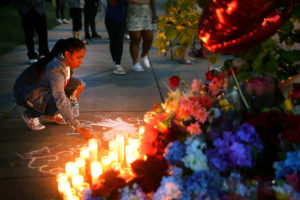A child smearing her friend’s blood on herself in an attempt to play dead. Agonised parents waiting to learn if their children had survived. The death of teacher Irma Garcia’s husband immediately after she was shot and killed, leaving their four children orphaned. It has been more than a week since Salvador Ramos stormed Robb Elementary School in Uvalde armed with a semiautomatic rifle, but the true nature of the tragedy — and the horror — is still coming into focus.
It would be wrong to say that the death of two teachers and 19 children in Uvalde has reignited a national debate over guns and gun control. It had already been reignited ten days earlier — by another mass shooting in Buffalo. Instead, the Texas shooting has only further polarised that debate, encouraging both sides to double down on their attempts to use senseless killings to justify their own political beliefs.
We hear the familiar arguments for stricter gun controls. We hear the usual counter-arguments for arming teachers. Senator Ted Cruz has called for single-point entries to schools. The exact opposite has been proposed by security expert Graeme Wood, who wants more exits so that students can escape. Last Friday, at the National Rifle Association (NRA) meeting in Houston, Donald Trump claimed that the country needs “a top-to-bottom security overhaul at schools across our country” to prevent active shooters. Meanwhile, outside the event, protestors (including Democratic politician Beto O’Rourke) held the NRA responsible for the exceptional frequency and scale of gun violence in the United States.
Political consensus, it would appear, seems a distant prospect. On Monday, the Canadian government banned the sale of handguns and proposed legislation that will require most owners of “military-style assault weapons” to turn over their rifles to the government. On the same day in Washington, President Biden was asked if talks between Republicans and Democrats would produce bipartisan gun legislation. He responded: “I don’t know.”
With America’s politicians evidently incapable of meaningful action on the central issue of access to firearms, it seems we have little option but to focus on other ways to prevent school shootings. Chief among these is fixing America’s failing mental health system. Texas Governor Gregg Abbott certainly appears to have learned this the hard way. After the Uvalde shooting, he demanded: “We as a state, we as a society, need to do a better job with mental health.” Yet there was also a certain emptiness to his words: a month before the attack, Abbott transferred $211 million away from the state’s Health and Human Services Commission, which oversees mental health programmes.
Consider this. Before Salvador Ramos dropped out of high school, there were clear indications that something was wrong. Students who knew him observed that he had changed from a quiet kid with a few friends into a hostile aggressor. While he did not have any reported mental health issues, the warning signs were there, particularly in his online behaviour. On Yubo, a social media app which includes livestream videos and chatrooms, Ramos was nicknamed “the Yubo school shooter”. He harassed girls in chatrooms, threatening to rape, murder, and kidnap them. On TikTok, a classmate told The Wall Street Journal, Ramos posted a video where “he was seated in the passenger seat of a car holding a bag with what appeared to be a dead cat in it”. The same behaviour surfaced on Instagram, where he posted pictures of him self-harming.
One doesn’t have to be a psychiatrist to understand that Ramos was unwell. Nor should it surprise us. Since the Columbine shooting in 1999, a disturbing number of school shooters have suffered from mental health conditions. Ethan Crumbley, who killed four students in Michigan last year, is planning an insanity defence. Dimitrios Pagourtzis, who shot up a high school in Santa Fe and killed 10 individuals in 2018, has been deemed unfit for trial several times by authorities and remains at a mental health facility. Nikolas Cruz, the shooter at Parkland’s Stoneman Douglas High School (also in 2018), suffered from depression, ADHD, and autism. Adam Lanza, the shooter at Sandy Hook Elementary School in 2012 — still the deadliest school shooting in American history — reportedly had Asperger’s syndrome and OCD. One L. Goh, who attacked Oikos University in Oakland in 2012, killing seven, was diagnosed with paranoid schizophrenia and deemed unfit to stand for trial. Steven Kazmierczak, the shooter at Northern Illinois University in 2008, was also diagnosed with schizophrenia. Seung-hui Cho, the shooter at Virginia Tech in 2007, was diagnosed with severe anxiety disorder with selective mutism and a major depressive disorder. The list goes on.
None of this is to suggest that poor mental health necessarily descends into violence. But there clearly are those whose illness manifests itself in the form of violent fantasies, and we need to have a better system for providing them with care and alerting the proper authorities.
The most obvious starting point would be improving America’s mental healthcare facilities. Take Texas, the state with the most school shootings since 2012. Texas’s mental healthcare is ranked dead last in the United States, according to Mental Health America, which measures both access to mental healthcare and the percentage of people with mental illness who do not have health insurance. It also ranks last regarding teenage access to mental healthcare. Texas is constructing a new psychiatric state hospital in Houston, but there is plainly a long way to go: since the Fifties, the number of state-run mental hospital beds in Texas has decreased by 95%.
But building new facilities will be nothing more than a sticking plaster unless our cultural approach to mental health also changes. In late 2021, the US Surgeon General declared a youth mental health crisis, reporting that between 2009 and 2019 suicidal behaviour among high schoolers was on the rise, “with 19% seriously considering attempting suicide, a 36% increase from 2009 to 2019”. McKinsey reported that “Gen Zers, ranging from middle-school students to early professionals, are reporting higher rates of anxiety, depression and distress than any other age group”.
Yet rather than asking why this is happening, our culture prefers to celebrate mental health conditions. Couched under the umbrella term “neurodivergence”, a plethora of psychiatric disorders are viewed as something to be idolised rather than cured: why bother to treat mental disorders when you can post about them on TikTok instead?
Well, after two mass shootings in just ten days, the cost of this trivialisation is becoming clear. The nightmare that unfolded in Uvalde might have been prevented if our society treated violent mental illness more seriously as a potential threat. The failure was more than just the ease with which the killer obtained a weapon and gained access to the school, or the sluggishness of the police response. It was a failure to identify and to treat a disastrously sick young man.
Disclaimer
Some of the posts we share are controversial and we do not necessarily agree with them in the whole extend. Sometimes we agree with the content or part of it but we do not agree with the narration or language. Nevertheless we find them somehow interesting, valuable and/or informative or we share them, because we strongly believe in freedom of speech, free press and journalism. We strongly encourage you to have a critical approach to all the content, do your own research and analysis to build your own opinion.
We would be glad to have your feedback.
Source: UnHerd Read the original article here: https://unherd.com



